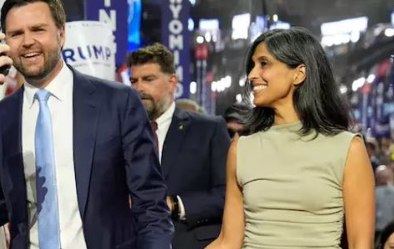
(Photo : X.com)
Usha Chilukuri Vance, wife of J.D. Vance, is set to be the first Indian-origin 'Second Lady' of the US.
- Trump's re-election has sparked speculation about the impact of his pro-tariff stance and EV policies on the US economy.
- Trump and VP-elect J.D. Vance have suggested redirecting EV subsidies towards US-made internal combustion engine vehicles.
- Trump's proposed tariffs could decrease foreign trade, potentially leading to a trade war, but could also increase tax revenue.
- Economists predict that these policies could decrease the US GDP and lead to retaliation from other countries, impacting the US and global economy.
The recent re-election of Donald Trump as the President of the United States has sparked a flurry of speculation and analysis regarding the potential impact of his administration's policies on various sectors.
One of the most significant areas of concern is the future of the US' Inflation Reduction Act (IRA) and federal electric vehicle (EV) manufacturing and consumer subsidies. Trump's administration has been known for its pro-tariff stance, with plans to use tariffs to offset corporate tax cuts. This approach is likely to have a significant impact on foreign trade, as reported by Counterpoint Research.
The administration has also publicly criticized the CHIPS Act, hinting at the possibility of repealing the Act and replacing it with tariffs on semiconductor companies. The government's EV subsidies have also come under scrutiny from both Trump and VP-elect J.D. Vance.
They have suggested that subsidies should be directed towards US-made internal combustion engine (ICE) vehicles instead. Despite this, Trump has expressed admiration for EVs from a technological perspective, and has received the full support and endorsement of Tesla chief Elon Musk.
Tesla and the Future of EV Manufacturing
This endorsement has led to speculation about whether Trump's approach to EV credits and manufacturing subsidies might change. Tesla, as the top beneficiary of IRA original equipment manufacturer (OEM) credits, would arguably maintain its market position in the US even without this funding. However, this funding greatly benefits other OEMs producing in the US, propelling them closer to competing with Tesla and China.
Trump has consistently positioned himself as a proponent of US automotive excellence. If he perceives Chinese vehicle technology as a threat to US OEMs, he is likely to maintain OEM subsidies awarded through the IRA. Trump's election is expected to maintain similar automotive tariffs, limiting OEMs' battery sourcing options to just a handful of companies and creating a demand-supply gap.
Trade Wars and the Global Economy
During his campaign, Trump promised to implement more tariffs. The initial tariffs imposed by Trump on China in 2018 under Section 301 are still in place. He is now proposing a 10 to 20 per cent universal tariff and levies of 60 per cent for China.
This could potentially decrease foreign trade and possibly lead to a trade war. On the other hand, it could increase tax revenue by $300 billion, with $200 billion of that coming from China. Trump has also threatened tariffs of 25 to 75 per cent on Mexican goods unless illegal immigration via the Mexican border is stopped.
Trump believes that taxes on foreign goods will relieve the US of its national debt, increase domestic manufacturing, and raise money for government programmes. However, economists predict that the US GDP will decrease by 0.2 per cent if he increases tariffs. China has stated it would retaliate, and undoubtedly other countries will too. Economists believe a trade war with other countries will impact the US GDP and capital stock negatively by 0.05 per cent.









